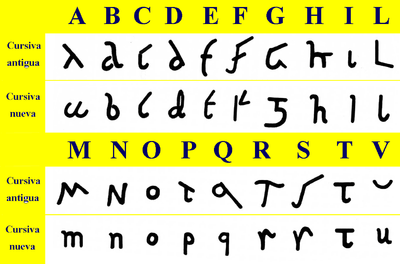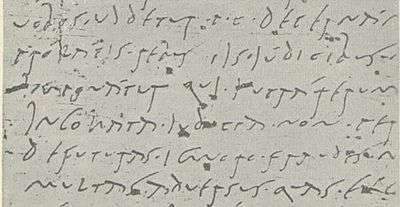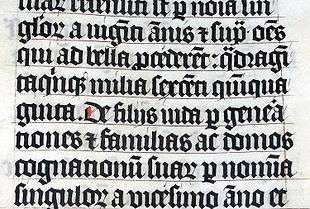Roman cursive
Roman cursive (or Latin cursive) is a form of handwriting (or a script) used in ancient Rome and to some extent into the Middle Ages. It is customarily divided into old (or ancient) cursive and new cursive.

Old Roman cursive
Old Roman cursive, also called majuscule cursive and capitalis cursive, was the everyday form of handwriting used for writing letters, by merchants writing business accounts, by schoolchildren learning the Latin alphabet, and even by emperors issuing commands. A more formal style of writing was based on Roman square capitals, but cursive was used for quicker, informal writing. Most inscriptions at Pompeii, conserved due to being buried in a volcanic eruption in 79 CE, are written in this script.

vobis · vjdétur · p · c · décernám[us · ut · etiam]
prólátis · rebus ijs · júdicibus · n[ecessitas · iudicandi]
jmponátur quj · jntrá rerum [· agendarum · dies]
jncohata · judicia · non · per[egerint · nec]
defuturas · jgnoro · fraudes · m[onstrósa · agentibus]
multas · adversus · quas · exc[ogitauimus]...
It is most commonly attested from the 1st century BCE to the 3rd century CE, but it likely existed earlier than that. In the early 2nd century BC, the comedian Plautus, in Pseudolus, makes reference to the illegibility of cursive letters:
Calidorus: Take these letters, then tell yourself what misery and concern are wasting me away.
Pseudolus: I will do this for you. But what is this, I ask?
Calidorus: What's wrong?
Pseudolus: In my opinion, these letters are seeking children for themselves: one mounts the other.
Calidorus: Are you mocking me with your teasing?
Pseudolus: Indeed, by Pollux I believe that unless the Sibyl can read these letters, nobody else can understand them.
Calidorus: Why do you speak harshly about these charming letters and charming tablets, written by a charming hand?
Pseudolus: By Hercules I beg you, do even hens have hands like these? For indeed a hen wrote these letters. (Plautus, Pseudolus, 21–30)
As the above extract shows, Old Roman cursive was considered difficult to read and roundly mocked even in its heyday, and as current cursive forms of the Latin script have evolved in another direction, it is hardly legible to modern readers. The script uses many ligatures, and some letters are hard to recognize – "a" looks like an uncial "a", but with the left stroke still straight, "b" and "d" are hard to distinguish, "e" is a full height letter (like the "s"), "p" and "t" are very similar, and "v" is written above the baseline, resembling a floating breve.[1]
New Roman cursive
New Roman cursive, also called minuscule cursive or later Roman cursive, developed from old Roman cursive. It was used from approximately the 3rd century to the 7th century, and uses letterforms that are more recognizable to modern readers: "a", "b", "d", and "e" have taken a more familiar shape, and the other letters are proportionate to each other rather than varying wildly in size and placement on the line.
These letter forms would gradually evolve into various scripts with a more regional character by the 7th century, such as the Visigothic script in the Visigothic Kingdom, the Beneventan script in southern Italy, or the Merovingian script in northern France. They also formed part of the basis of the uncial and half-uncial scripts, particularly for the letters "a", "g", "r", and "s".[2]
See also
Notes
- Oxford, Scripts at Vindolanda page 2 page 3
- Oxford, Scripts at Vindolanda: Historical context.
References
- Jan-Olaf Tjäder, Die nichtliterarischen lateinischen Papyri Italiens aus der Zeit 445–700 (Lund, 1955).
- Vindolanda Tablets on line, Centre for the Study of Ancient Documents and the Academic Computing Development Team at Oxford University.
Further reading
- 'Manual of Latin Palaeography' (A comprehensive PDF file containing 82 pages profusely illustrated, June 2014).
- Latin cursive presented by the University of Michigan Papyrus Collection
- Vindolanda: Roman documents discovered, Current Archaeology, a World Wide Web article, based on a fuller accounts in Current Archaeology Nos. 116, 128. 132 and 153.
